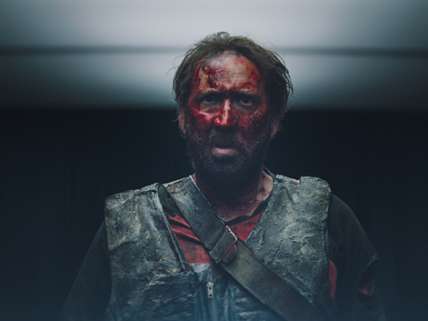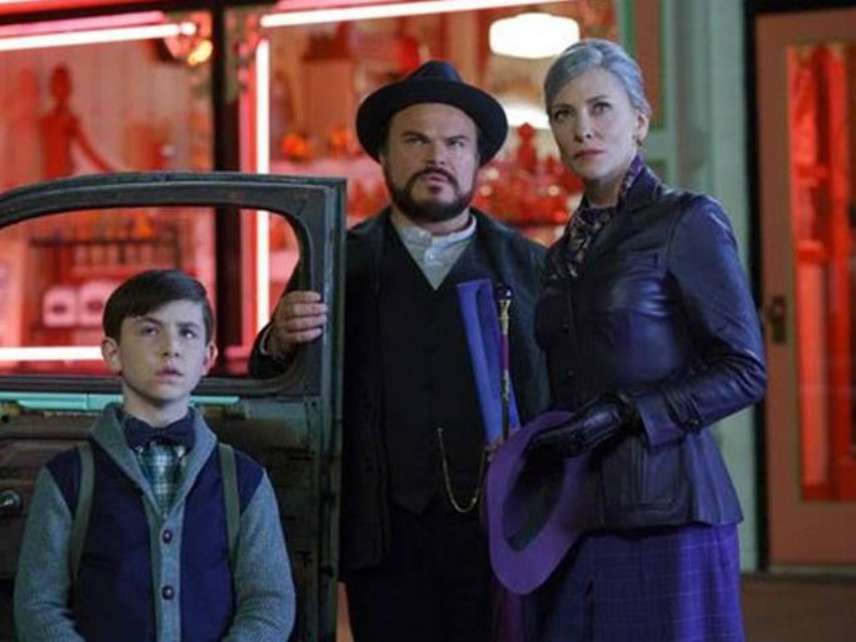Movie Reviews: Mandy and The House with a Clock in Its Walls
Nicolas Cage finally finds a home-not the case for Jack Black and Cate Blanchett.

Nicolas Cage is of course perfect for Mandy, the wonderfully wild and way-overcranked new midnight movie by Canadian director Panos Cosmatos. It's easy to forget that Cage was once awarded an Oscar (for the 1995 Leaving Las Vegas), and it's good to see that he's still able to make something warmly human out of the first half of the movie, in which his character, a gentle logger named Red Miller, mostly trades nuzzles and murmurs with his doomed sweetie, a haunted-looking artist named Mandy Bloom (Andrea Riseborough). But Cage is also the actor (and the desperate tax delinquent) who has given us such crap classics as Bangkok Dangerous, Ghost Rider, and the insane Wicker Man remake ("Not the bees! Not the bees!"). So when the movie swerves out on a highway to hell in its second half, the Nic is ready to roll.
If truth be told, Cage may be a little too perfect for his character here, and Cosmatos uses him in ways that are sometimes too facile. One scene that has already elicited grunts of admiration among early adopters of this custom-made cult item consists of nothing but Nic standing in a bathroom, in his underwear, loudly flipping out. Okay, Red has just been forced to watch his beloved Mandy burned alive in a bag hung from a tree, and he's been taking an awful lot of shit from a group of degenerate Jesus freaks called Children of the New Dawn, and from their demonic associates, a drug-running biker gang that is almost certainly not of this earth. So after closing the bathroom door, Red reaches down into the cabinet where he for some reason keeps his liquor, pulls out a fifth of vodka/gin/whatever, pours some of it straight down his throat and sloshes the rest over a wound in his side (he was recently stabbed with a "sacred blade" from—gamer alert—"the Abyssal Lair") and over his bloody wrists, still raw from having been bound in (crown-of-thorns alert) barbed wire. Cage gives this scene a full-body embrace, naturally, howling and weeping and generally doing it to death—which may be the most unsurprising thing in the movie. It's another "classic" Nic moment, but that's all it is.
For most of the movie, though, the man is aces. (Who else would go anywhere near a line like, "You're a vicious snowflake"?) And amid all gushing blood and the ambient wooze, he gets solid nutzoid support from Linus Roache, who plays the murderous New Dawn leader Jeremiah as a pop-rocking psychopath ("Do you like the Carpenters?"), and Ned Dennehy as Brother Swan, Jeremiah's bad lieutenant, who looks as if he's had someone else's dead face grafted onto his own. Andrea Riseborough (whose paintings here are the work of fantasy-art star Julie Bell) may not make it all the way through the movie, but she creates an eerie aura of loss around her character that permeates the whole picture. (It's a feeling emphasized by the director's fixation on red filters, which has the effect of turning the actress' eyes a ghastly black in some of her several hazy scenes.)
The movie's real star is Cosmatos himself, who co-wrote the script with Aaron Stewart-Ahn, and finally managed to get the picture made eight years after his debut feature, the similarly psychedelic Beyond the Black Rainbow (which like this film is also set in 1983). He wears his influences blithely. From David Lynch he's taken fritzing light fixtures, unexplained mystery drugs, and even Frank Booth's cri de coeur, "Don't you fuckin' look at me!" And the bloody chainsaw duel he stages here would seem to be a tribute to the one between Dennis Hopper and Leatherface in The Texas Chainsaw Massacre 2.
But Cosmatos is weird in his own enjoyable way, too. He stages a vicious cocaine-fueled smackdown in front of a TV throbbing to the silent carnal rhythms of an obscure Harry Reems porn flick. And he brings the movie to a brief, hilarious halt when we see Cage gawping at a commercial featuring a personage called the Cheddar Goblin (you can already follow him on Twitter).
By the time the movie ends, you realize that you've just seen a pretty traditional revenge thriller, but that it has unreeled like no other revenge thriller ever made. For anyone who ever took way too many drugs, this movie will bring that panicky feeling roaring back. For anyone who's longed to dive deep into lagoons full of writhing synthesizers, this is the pic for you. (The score is the last by the late and truly great Jóhann Jóhannsson.) The movie is also worth seeing for some exceptionally out-there lines. (Preparing to terminate a skeeze at one point, Red says, "The psychotic drowns, while the mystic swims. You're drowning.") In short, if you're a fan of the crazy, and the copious buckets of blood that should ideally accompany it, well, here ya go. It's available on demand, but you know you want to see it on a big screen, and very loud.
The House with a Clock in Its Walls

Jack Black and Cate Blanchett may get most of the face space on the poster, but the real star of The House with a Clock in Its Walls is production designer Jon Hutman. The cumbrously titled movie is set in the year 1955, but most of the action takes place in a big, overstuffed mansion that suggests the Victorian era, filled as it is with heavy wooden furniture, coffered ceilings, tassled lampshades, spooky antique dolls and all manner of other eccentric bric-a-brac. The atmosphere very much recalls Edward Gorey, the artist whose mock-ominous illustrations grace the 1973 John Bellairs novel from which the movie is adapted. The film is a rich visual experience—Hutman should come out and take a bow after the end credits. Most everybody else can stay seated.
The movie is a first venture into PG territory for director Eli Roth, who's better known as a gross-out horror specialist (The Green Inferno, the Hostel movies). But he seems becalmed by the lack of need for bloody shocks in this mild story of a recently orphaned boy named Lewis (Owen Vaccaro) who has come to the Michigan town of New Zebedee to live with his rather strange uncle Jonathan (Jack Black), who turns out to be a warlock, although not a very good one ("just a parlor magician, really," he admits). Next door resides Mrs. Zimmerman (Cate Blanchett), a once-celebrated good witch whose powers have mysteriously ebbed. Also lurking about, mostly toward the end, is Isaac Izard (Kyle MacLachlan), Jonathan's partner in a long-ago magic act; Isaac disappeared into the Black Forest one day and emerged later as an evil wizard. He's now dead (well, "dead"), as is his evil wife Selena (Renée Elise Goldsberry).
The big house originally belonged to Isaac, and he rigged it with a special clock that's hidden in one of its walls. The clock is capable of reversing time and rewinding it back to Year Zero, at which point the misanthropic Isaac will ensure that the human race never gets started. Jonathan is obsessed with preventing this and soon Lewis has joined his cause, along with Mrs. Zimmerman. There are some impressive effects along with way—a nighttime garden with scaled-down stars and planets drifting around in it, an attack by a gang of pumpkin demons—but the movie's uncertain tone and desultory, on-and-off search for the clock drains the movie of snap and sparkle. Blanchett is wasted in an underwritten role – we're told that Mrs. Zimmerman has lost a child, and we suspect that may have been the cause of her waning powers; but we never learn any more. And Jack Black, recently so moving in Gus Van Sant's Don't Worry, He Won't Get Far on Foot, has been rewound to basically playing Jack Black.
The story might have worked better in the hands of a young Tim Burton, that master of dark undertones. As executed here, it plays like a Tim Burton movie in which Tim Burton himself lost interest early on.


Show Comments (3)